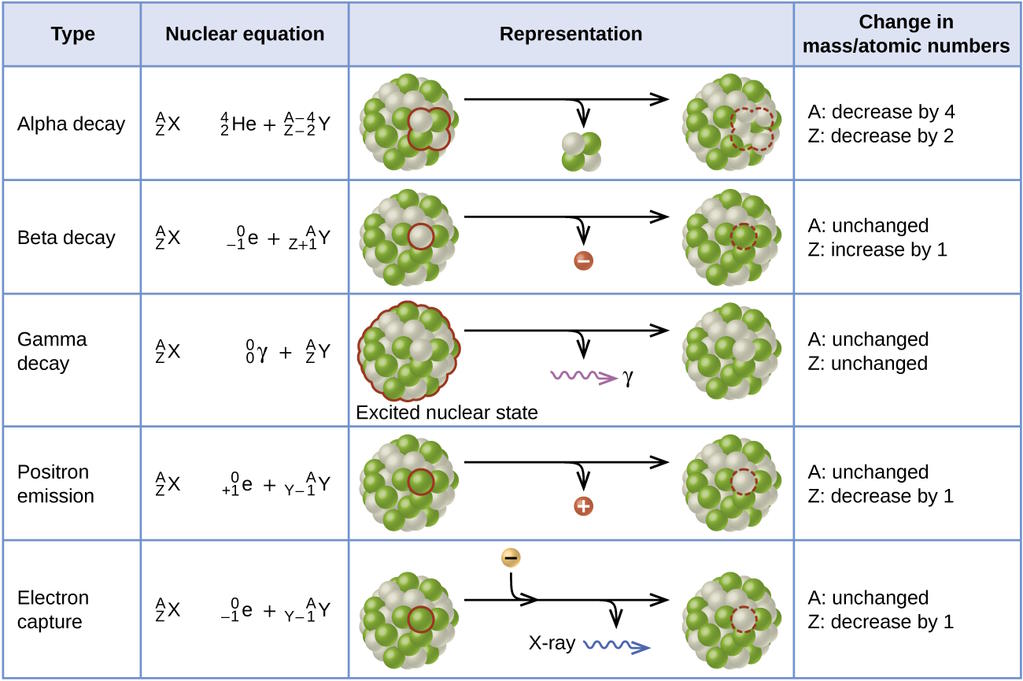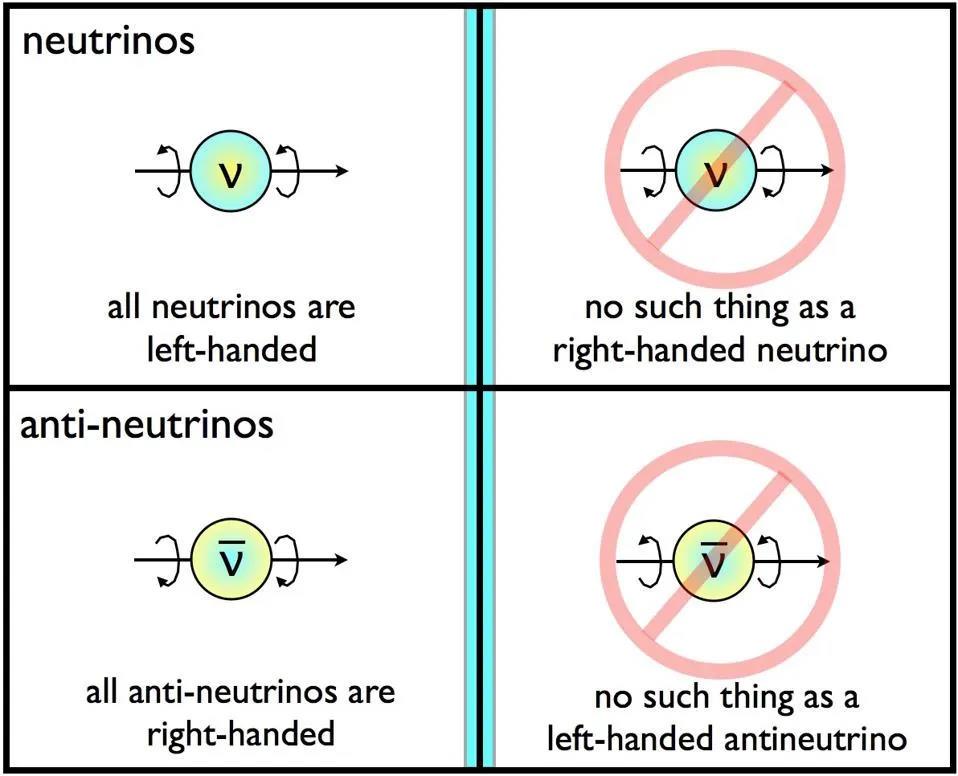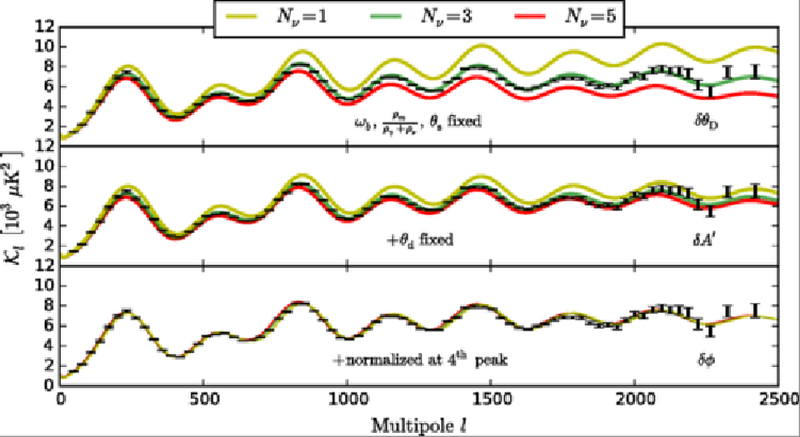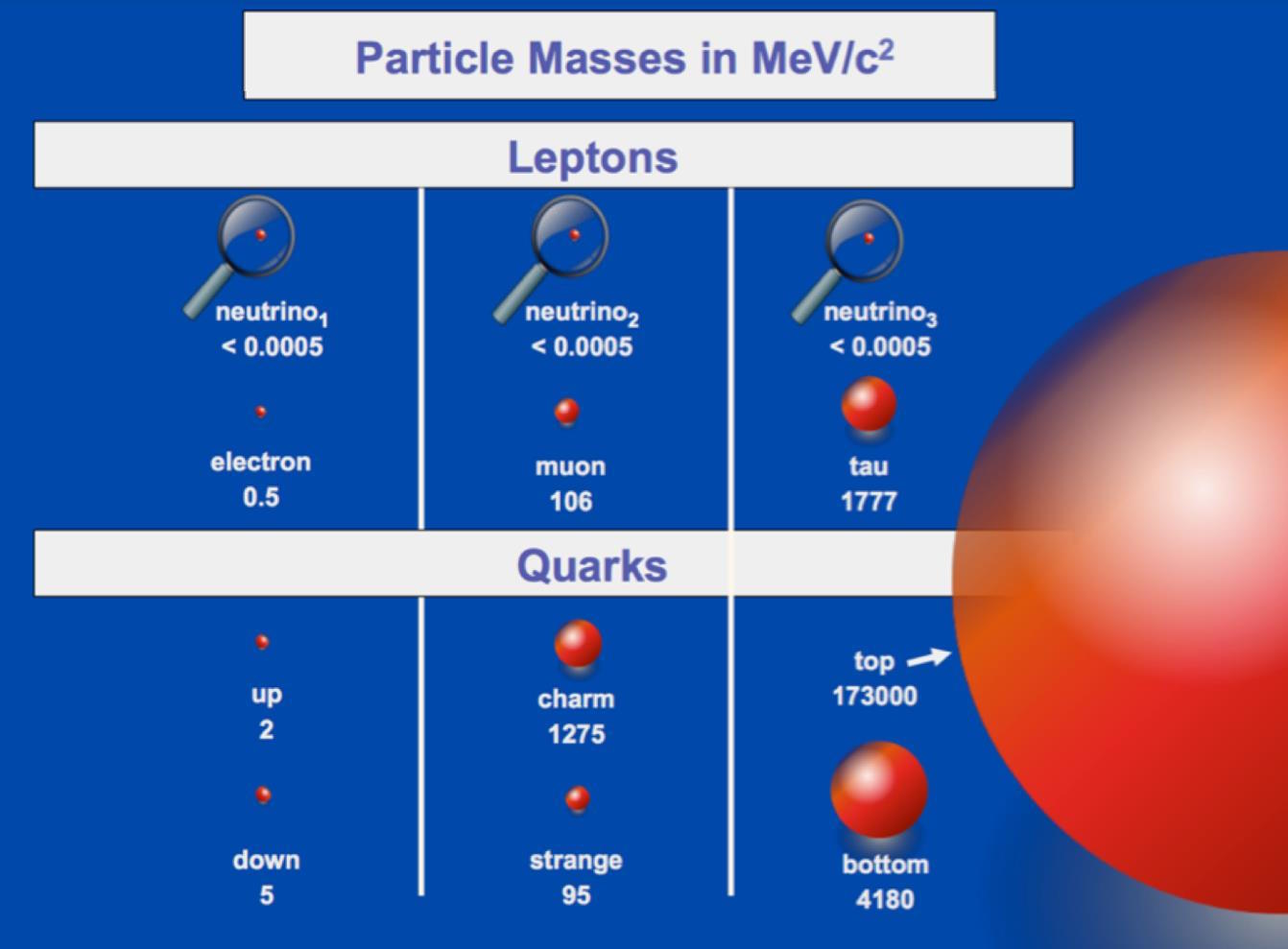The mystery of neutrino mass is now smaller than ever


There are many puzzles out there about the very nature of reality that remain to be solved. Many of the big ones include dark matter, dark energy, the ultimate origin of space and time, and why our Universe is made of normal matter and not an equal amount of antimatter. But even though they’re largely derided as “cosmically unimportant,” the humble neutrino presents a tremendous cosmic mystery as well. First proposed way back in 1930 as a possible explanation for why some types of radioactive decays seemed to violate the conservation of energy, neutrinos (and antineutrinos) were first directly detected in the 1950s, and are an important part of the Standard Model of particle physics.
Neutrinos were once a candidate for dark matter, and have indeed been shown to have mass. They’ve been caught oscillating, or changing species, from one flavor into another, and actually represented a significant fraction of the Universe’s total energy density in the early stages of cosmic history. Although we’ve placed indirect constraints on their masses from cosmic measurements (such as of the cosmic microwave background), there’s never a substitute for direct measurements. In a tour-de-force result, the KATRIN experiment has just placed the tightest ever constraints on the mass of the electron neutrino, showing that it can be no more massive than 0.45 eV/c², or less than one-millionth the mass of an electron.
Here’s what it means for the Universe, and why it’s so important, from a cosmic perspective, to further pin down the properties of the most elusive particle(s) in all the Standard Model.

The origin of neutrinos goes all the way back to a puzzle associated with radioactive decay. From the late 19th century into the early 20th century, scientists not only uncovered the phenomena of radioactive decay, but they divided them into three general categories:
- alpha (α) decay: where an unstable atomic nucleus spits out a helium-4 nucleus, leaving a lighter nucleus with two units less of electric charge,
- beta (β) decay: where an unstable atomic nucleus spits out an electron, leaving an almost-identical mass nucleus with one more unit of electric charge,
- and gamma (γ) decay: where an unstable nucleus spits out a high-energy photon, leaving an almost-identical mass nucleus with the same units of electric charge.
On top of this, the equivalence of mass and energy (via E = mc²) was established by Einstein back in 1905.
Since energy must be conserved, it stood to reason that if you started with the mass of the initial atomic nucleus and converted it into energy (via E = mc²), then if you added up the masses of all of the products of the decays and the kinetic energies (or energy of motion) of all of those products — including daughter nuclei, electrons, and photons — then those two amounts of “total energy,” initial and final, must balance.
And they did: for all α-decays and all γ-decays. But for β-decays, there was a gap. If you added up the masses of the daughter nucleus and the electron, and you also added in their kinetic energies, the “final energy” was always less than the “initial energy.”

Did this mean that the conservation of energy could be violated by a certain class of radioactive decays? Nobody in theoretical physics was happy about this development, and even Niels Bohr considered that the most hallowed of conservation laws could be violated in these instances. Then, in 1930, Wolfgang Pauli had a brilliant but risky idea: to hypothesize the existence of a new particle. This particle would have to be electrically neutral, would have to have extremely little (or even no) mass, and it must be extremely hard to detect. He named it “neutrino,” which is Italian for “little neutral one.” Upon putting forth his idea, he expressed what appeared to be some sort of shame, proclaiming,
“I have done a terrible thing, I have postulated a particle that cannot be detected.”
But it could be detected: at least, in principle. Practically any reaction that occurs one-way in physics can also occur in the other direction. Neutrinos can be emitted in reactions involving the atomic nucleus, but they can also be absorbed in reactions that involve nuclei as well. As we came to understand matter and antimatter, as well as the intricacies of the nuclear forces (especially the weak nuclear interaction) and how nuclear reactions proceed, a method for detecting them was developed. Involving a nuclear reactor and a large tank of detector material, the first (anti)neutrino was detected in 1956, leading to a Nobel Prize for proving the existence of the neutrino.

Although it was a remarkable advance, it wasn’t long before a new puzzle arose: the solar neutrino puzzle. We had begun to understand, by the 1960s, how nuclear fusion inside stars like the Sun worked: through the proton-proton chain and the CNO cycle. In both instances, the net result is that protons — the primary composition of Sun-like stars — are fused into heavier elements like helium. These fusion reactions are responsible for:
- releasing energy,
- producing photons,
- resulting in the production of positrons (which annihilate with already-present electrons to produce more high-energy photons),
- and producing neutrinos, specifically electron-flavored neutrinos.
These predictions were non-controversial even back in the 1960s, and based on the observed energy output of the Sun, the flux of electron neutrinos could be calculated. Since we had already begun detecting antineutrinos, conducting an experiment to detect solar neutrinos — i.e., electron-flavored neutrinos produced by the Sun — was a straightforward endeavor. Even though the interaction cross-section for neutrinos is tiny (and dependent on their kinetic energies), the experiments used large tanks of interaction material to observe a tiny fraction (but a substantial number of total particles) of those neutrinos.
But when the numbers came in, there was a huge puzzle: only about a third of the expected signal appeared.

Why was this? For decades, many astronomers and physicists dismissed the solar neutrino puzzle. They argued that either we didn’t understand neutrinos, we didn’t understand the Sun correctly, or we didn’t understand how the detectors worked properly. Yet even as our understanding of all of those areas improved, the mismatch between what we predicted and what we were seeing remained, and remained in a consistent fashion. There were still far fewer, by about a factor of three, neutrinos observed coming from the Sun than we predicted ought to come from the Sun.
Sure, it was possible that there was an error somewhere — an error that we hadn’t yet identified — and that the skeptics would eventually be proven right.
But it was also possible that the neutrino sector was more complex than we had originally imagined. There’s a phenomenon in quantum physics known as mixing: when particles that have similar properties (same electric charge, same spin, same lepton/baryon number, etc.) but different identities and different rest masses, they can mix together to form a mixed quantum state. Quarks mix together, for example, with up-charm-top quarks mixing and down-strange-bottom quarks mixing (as well as the respective antiquarks plus any quark-antiquark combinations), causing them to oscillate from one species into another. If neutrinos had mass, they could “mix” in this fashion as well.
But massive neutrinos would be weird!

Consider this: neutrinos are always left-handed (if you point your thumb in the direction of their motion, their angular momentum curls in the direction of your left hand’s fingers) while antineutrinos are always right-handed. This is easy to understand if you always move at the speed of light (which massless particles must do), but difficult to comprehend if neutrinos move slower than light. After all, if you saw a left-handed neutrino, you could speed up so that its direction of motion would appear to reverse; would that create a right-handed neutrino or a left-handed antineutrino? Either one is an impossibility, as far as we know.
In fact, we have almost 300 neutrinos and antineutrinos, combined, per cubic centimeter of space everywhere in the Universe: left over from the hot Big Bang itself. If they were massless, they would have just continued to travel at the speed of light forever, never clumping or clustering at all. Just like the (truly massless) photons left over from the Big Bang, they would free-stream in a straight line, creating a cosmic neutrino background in analogy with the cosmic microwave background.
But if neutrinos had mass, they would only behave like radiation early on: when they had enough kinetic energy that they moved close to the speed of light. At late times, they would cool and slow down, allowing them to clump, cluster, and gravitate. In other words, they would be a form of dark matter.
In fact, there are so many neutrinos that if their combined mass (of all three species: electron, mu, and tau) turned out to be somewhere around just 45 eV/c² (electron-volts-per-speed-of-light-squared), they could make up 100% of the energy density of the Universe. With a combined mass of ~15 eV/c² or so, they could make up 100% of the dark matter that’s present.

Now, astrophysically, we don’t have the ability to measure the actual masses of the neutrinos that we have; we don’t have a way of doing that. What we can do, however, is measure a suite of different things.
- We can measure how the imperfections in the Big Bang’s leftover glow, the cosmic microwave background, are affected by the presence of neutrinos early on, and come up with an estimate for the abundance and temperature (but not mass) of the neutrinos present.
- We can measure how the acoustic scale, calculable from baryon acoustic oscillations in the early Universe and appearing in galaxy clustering data in all the time since, is affected by the early presence of neutrinos, confirming the presence and properties of the cosmic neutrino background.
- We can measure the presence, energy, and flux of solar neutrinos, and compare them with model predictions; there is indeed a solar neutrino deficit, confirming that 100% of the generated electron neutrinos do not make it all the way to Earth before oscillating into a different neutrino species.
- And we can also measure the presence, energy, and flux of neutrinos produced via cosmic ray interactions with Earth’s atmosphere, which probes a different species type (muon neutrino) of neutrino and their oscillation properties than the solar neutrino experiments.
When we combine all the different lines of evidence together, we find that there is indeed a spectrum of neutrinos produced: mostly in the Big Bang but then secondarily from stars and from cosmic rays, and that they aren’t massless, but rather have small, non-zero rest masses, as evidenced by neutrino oscillations.

The measurements of neutrino oscillations allow us to say something about the mass differences between the different types of neutrinos, but they don’t tell us what the absolute mass of the neutrino is. To find that, we need a direct detection experiment. This is exactly what KATRIN is: the Karlsruhe Tritium Neutrino experiment, and it seeks to measure the mass of the electron neutrino by precisely re-creating the initial type of decay that fascinated Wolfgang Pauli nearly a full century ago. The measurement principle is simple:
- take a large number of unstable tritium atoms,
- know that each time a tritium atom decays, it produces a helium-3 nucleus, an electron, and an electron antineutrino,
- then measure the mass and kinetic energy of each helium-3 nucleus and electron that gets produced,
- and plot the amount of “missing energy,” or initial mass/energy minus final mass/energy, for all events together.
If the neutrino were truly massless, then there would be a distribution that had fewer and fewer events with smaller energy differences, with the rarest of events happening just a minuscule amount of energy away from having initial and final energy balance exactly: with no missing energy at all.
But if the neutrino had a non-zero rest mass, then there would be some form of missing energy even with the rarest of all events; there would be a “gap” between “no missing energy” and the rarest observed event. What KATRIN saw was consistent with no gap and no missing energy, constraining the mass of the electron neutrino (and antineutrino) to be no greater than just 0.45 eV/c², giving us our tightest constraints (and the lowest upper limit) on just how massive neutrinos can be of all-time.

Now, this is very, very important, because if the electron neutrino can be no more massive than about 0.45 eV/c², it means that the maximum mass that the other two neutrino species can possess are 0.46 eV/c² and 0.51 eV/c², which means that — at maximum — neutrinos make up less than 10% of the dark matter that’s out there. It also means that if we can get that limit down just a little bit further, down to about 0.06 eV/c², we’re extremely likely to actually discover what the mass of (or mass constraints on) the neutrinos we have in our Universe are.
It’s also important because, from measurements of the large-scale clustering of galaxies and the polarization of the cosmic microwave background, we can also infer limits on the sum of the neutrino masses of all three species of neutrino (no more than about 0.72 eV/c²), and they’re getting close to the lower-limit value of 0.06 eV/c² which is set by neutrino oscillation data.
On the one hand, it looks like cosmology data shows no evidence for neutrino mass at all. On the other hand, neutrino oscillation data demonstrates that neutrinos must have mass, and that there’s a difference in mass between the various mass states. (Note that, because of mixing, the electron, mu, and tau neutrinos are mixtures of the three mass states allowed; they are not “pure states,” but rather mixed states.) Neutrinos must be massive, but we don’t know what those masses are.

That’s why a direct measurement of mass, or even a direct upper limit on the mass of any one of the species of neutrino, is so powerful for understanding some fundamental properties of reality. In the rest of the Standard Model, the lightest particle with a non-zero mass is the electron, while the heaviest, the top quark, is around 340,000 times heavier than the electron. As of right now, the KATRIN data tells us that, at most, the neutrino is more than a factor of 1.1 million lighter than the electron, highlighting just how bizarrely low in mass neutrinos are. With about four times as much data, total, to analyze, KATRIN will either find a non-zero mass for a neutrino or will constrain them so that we’ll know their rest masses are below about 0.2 eV/c², a constraint that was practically too good to imagine at the turn of the millennium.
From neutrino oscillation data, we have a lower limit on neutrino masses; they must have non-zero mass. From cosmology, we don’t have any evidence for neutrino mass, with many measurements even favoring negative neutrino masses, highlighting the tensions that are present between different cosmic data sets. It’s for those reasons that a direct upper limit on neutrino masses is so vitally important to pinning down these fundamental properties of the Universe. As Alexey Lokhov of the Karlsruhe Institute of Technology (and KATRIN member) put it:
“We need to be very cautious, because we’re entering a region of parameter space that no one has measured directly and no one will be able to cross-check for a couple of years at least.”
Neutrinos do indeed have mass. But what, exactly, is that mass? Although it’s now constrained to be smaller than ever, the puzzle still looms large for its cosmic implications.
This article The mystery of neutrino mass is now smaller than ever is featured on Big Think.
What's Your Reaction?
 Like
0
Like
0
 Dislike
0
Dislike
0
 Love
0
Love
0
 Funny
0
Funny
0
 Angry
0
Angry
0
 Sad
0
Sad
0
 Wow
0
Wow
0










































